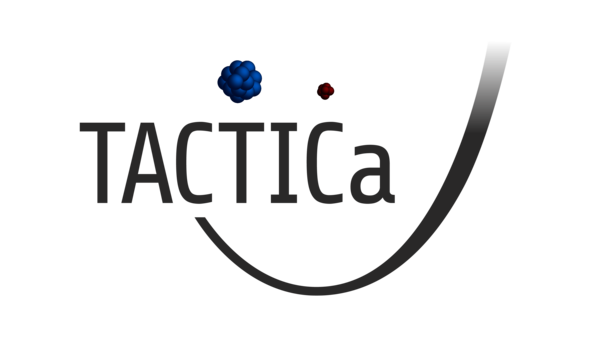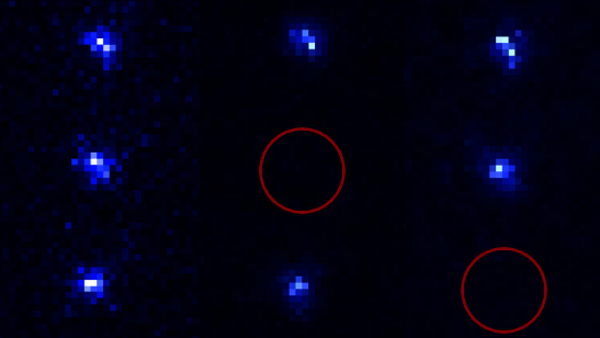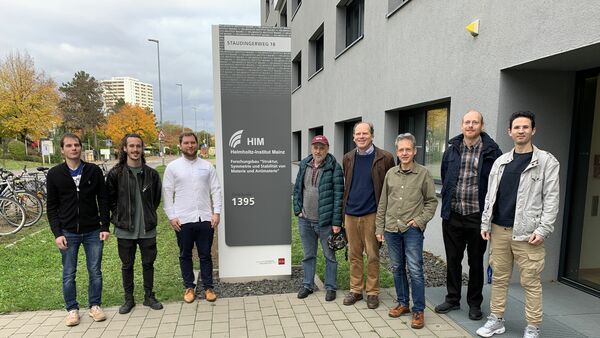TACTICa: Trapped And Cooled Thorium Ion spectroscopy via Calcium


Images of three fluorescent calcium ion crystals with 1. three calcium ions without a defect, 2. one thorium ion as a defect in the middle, and 3. one thorium ion as a defect on the side of the crystal. Photo/©: Can P. Leichtweiß / Univ. Mainz

Group photo of the current members of the TACTICa cooperation. Photo/©: Lisa Kraft / HI Mainz
Principal Investigators:
- D. Budker (Helmholtz Institute Mainz; PRISMA+ Cluster of Excellence;
Institute for Physics - QUANTUM group, Matter - Antimatter Asymmetry, JGU Mainz) - Ch. E. Düllmann (Helmholtz Institute Mainz; PRISMA+ Cluster of Excellence;
Department Chemistry - TRIGA Site, Superheavy Element Chemistry, JGU Mainz;
GSI Helmholtzzentrum für Schwerionenforschung Darmstadt) - F. Schmidt-Kaler (Helmholtz Institute Mainz; PRISMA+ Cluster of Excellence;
Institute for Physics - QUANTUM group, Quantenbit AG, JGU Mainz) - L. von der Wense (Institute for Physics - QUANTUM group, NuQuant, JGU Mainz)
Research:
TACTICa uses atomic physics methods to investigate thorium isotopes including the metastable low energy nuclear state in 229mTh. The optical ground state transition of isomeric 229Th is the only nuclear transition that potentially can be interrogated using lasers. Controlling this transition opens an interesting window into high-precision tests of the standard model and on possible variation of fundamental constants.
Thus TACTICa aims to deploy ion trapping techniques like quantum logic spectroscopy to gain access to the nuclear structure of thorium.
TACTICa aims for combining unique expertise of nuclear chemistry and experimental quantum science. This way, we will first vastly improve the accuracy of spectroscopic investigations of the nuclear Th isotopes including the isomer in 229Th, and eventually realize quantum logic spectroscopy and quantum-enhanced measurements on thorium for fundamental research.
Th ion sources:
TACTICa follows two different approaches for Th ion production: 1. Laser ablation of macroscopically samples of thorium and 2. Alpha decay of uranium mother nuclides. Therfore, a laser ablation setup has been built and is being used to implement Th into Ca ion crystals. In addition, two test stands were developed, one to study the decelartion of thorium recoil nuclei after the alpha decay of uranium isotopes, and also a second laser ablation setup were built for experiments with rare isotopes. For further information visit Sources of TACTICa.
Ion trap:
TACTICa uses state of the art ion trapping techniques to test the standard model of physics with highest precision and respect to precise determination of the nuclear moments, hyperfine intervals, and isotopic and isomeric shifts of thorium ions. These Th ions are trapped and sympathetically cooled inside of a calcium ion crystal in a Paul trap designed and developed in the Quantenbit AG.
Results:
As an important first demonstration, in 2018, single 232Th+ ions were trapped together with Ca+ ions forming a so-called “Wigner crystal”, sympathetically cooled and characterized.
The ions were successfully trapped in a linear Paul trap, and their mass was identified via a time-of-flight (TOF) measurement as well as from the voids in the laser-induced Ca+ fluorescence pattern emitted by the Wigner crystal. This paves the way to future high-precision studies of various Th isotopes including 229mTh in the context of fundamental physics or quantum optics.
News

Images of fluorescent calcium ions in a crystal with a linear structure (top image) and in a crystal with a zigzag structure (bottom image). Photo/©: Dr. Wenbing Li / Univ. Mainz
The picture shows a linear crystal of Ca+ ions when the confinement in the radial direction is tighter than that in the axial direction. When the number of ions is increased and the radial potential can not keep the ions in a linear chain, the ion crystal undergoes a “phase transition” and assumes a zigzag shape, as shown in the lower image. The distance between adjacent ions strongly depends on the axial trap potential; inner ions are closer to their neighbors compared to outer ions since the ions at the inner positions are more confined. Here the average distance between adjacent ions is 10 to 20 µm. A thorium ion trapped in such a crystal appears as a “crystal defect.”
Publications
- Marvin Gajewski, Wenbing Li, Sebastian Wolf, Walter Hahn, Christoph E. Düllmann, Dmitry Budker, Giovanna Morigi, and Ferdinand Schmidt-Kaler,
Fluorescence calorimetry of an ion crystal,
Phys. Rev. A 106, 033108 (2022), arXiv:2204.06513. - Wenbing Li, Sebastian Wolf, Lukas Klein, Dmitry Budker, Christoph E. Düllmann, and Ferdinand Schmidt-Kaler,
Robust Polarization Gradient Cooling of Trapped Ions,
New J. Phys. https://doi.org/10.1088/1367-2630/ac6233 (2022); arXiv:2109.00575. - R. Haas, M. Hufnagel, R. Abrosimov, Christoph E. Düllmann, Dominik Krupp, Christoph Mokry, Dennis Renisch, Jörg Runke, Ulrich W. Scherer,
Alpha spectrometric characterization of thin 233U sources for 229(m)Th production,
Radiochim. Acta 108, 923 (2020). - Raphael Haas, Tom Kieck, Dmitry Budker, Christoph E. Düllmann, Karin Groot-Berning, Wenbing Li, Dennis Renisch, Ferdinand Schmidt-Kaler, Felix Stopp, and Anna Viatkina,
Development of a recoil ion source providing slow Th ions including 229(m)Th in a broad charge state distribution,
Hyperfine Interactions (2020) 241:25; arXiv:1911.11674. - Karin Groot-Berning, Felix Stopp, Georg Jacob, Dmitry Budker, Raphael Haas, Dennis Renisch, Jörg Runke, Petra Thörle-Pospiech, Christoph Düllmann, and Ferdinand Schmidt-Kaler,
Trapping and sympathetic cooling of single thorium ions for spectroscopy,
Phys. Rev. A 99, 023420 (2019); arXiv:1807.05975. - Felix Stopp, Karin Groot-Berning, Georg Jacob, Dmitry Budker, Raphael Haas, Dennis Renisch, Jörg Runke, Petra Thörle-Pospiech, Christoph E. Düllmann, Ferdinand Schmidt-Kaler,
Catching, trapping and in-situ-identification of thorium ions inside Coulomb crystals of 40Ca+ ions,
Hyp. Int. 240, 33 (2019).
